This content is viewable by Everyone
Voicemail FAQs
- Service Category: Phones & Pager
- Owner Team: IT DWS Unified Comms
-
Service:UCSF Voicemail
Return to UCSF Voicemail service page
Overview
- What is UCSF Voicemail?
- Is there a fee for the voicemail service?
- What telephones are supported with the Cisco Unity voicemail service?
- How do I listen to a voicemail message via voice commands?
Setup
- How do I access and set up my voicemail for the first time?
- How do I change my (or retrieve a lost) personal identification number (PIN)?
- Is it okay to use my old PIN?
- Will I still get notified of missed calls with the Cisco Unity voicemail system?
- Will I still get my voicemail delivered to my email address, so I can listen from my Outlook client with the new system?
- What voicemail functions can I manage through the Outlook web app (OWA)?
- I have set up customized call-routing rules; will I be able to do that on the new system?
- What features require submitting a ticket to the IT Service Desk?
Voice commands
- What are voice commands?
- What are the voice commands menu options?
- How do I activate voice command menu options?
How-tos
- How do I record my name?
- How do I record alternate greetings?
- How do I reply to a voicemail message?
- How do I forward a voicemail message?
- How do I listen to a voicemail message via touch-tone?
- Do voicemail messages count against my mailbox quota?
- If I delete a voicemail message from my Outlook email inbox, am I still able to listen to the message from my phone?
- Is it okay for people to leave me confidential information, such as patient or personal information, on a UCSF voicemail message?
- Are "secure" voicemail messages allowed with UCSF voicemail?
- Is voicemail text preview supported?
- How do I choose the touch-tone keypad interface on my phone, instead of having to talk to the system?
- How do I set up call-answering rules for voicemail?
- Will the University be providing training sessions for the new voicemail system?
- How do I save voicemail messages within Outlook for longer than 1 year (356 days)?
Cisco Phone Quick-Start Guides
Overview
What is UCSF Voicemail?
- UCSF Voicemail is the new term for our advanced voicemail technology service. It is based on the Cisco Unity Connection voicemail and messaging platform.
Is there a fee for the voicemail service?
- There is no additional fee for UCSF Voicemail if you are paying the monthly cost for a phone line, however if only voicemail is needed and no physical phone you will still pay the same monthly flat rate as you would for a phone line.
What telephones are supported with the Cisco Unity voicemail service?
- UCSF Cisco Unity Voicemail is available to Campus and Medical Center employees using Cisco or Centrex phone systems.
- For telephone numbers beginning with prefix 597, the AT&T voicemail solution is available.
- For telephone numbers beginning with prefix 206, contact the IT staff at SFGH.
Setup
How do I access and set up my voicemail for the first time?
1. Call the Voice Access number appropriate for your location, as listed below:
- From a Campus phone, call x66000 or press the Message Waiting button on your phone.
- From an off-campus phone, call 415-476-6000 and press the Star key when you reach the voicemail system. You will be prompted for your ID; enter your 5-digit phone extension number (UCSF St Marys staff enter full 10 digits).
- From a mobile phone, call 415-476-6000 and press the Star key when you reach the voicemail system. You will be prompted for your ID; enter your 5-digit phone extension number (UCSF St Marys staff enter full 10 digits).
2. Enter your Personal Identification Number (PIN), and press #. Note: If this is your first time logging in, enter your temporary PIN and press #. You will be prompted to select a new PIN and enter it. Your temporary PIN will be provided when your account is set up.
How do I change my (or retrieve a lost) Personal Identification Number (PIN)?
- First, note that you cannot change your PIN more than once in a 24-hour period.
- To change your PIN, log into the Cisco Personal Communication Assistant (PCA) web portal:
- Copy "https://voicemail.ucsf.edu/" to your clipboard. Note: There is a known issue with this version of the Cisco PCA that prevents direct access from a referral web page.
- Paste it into your web browser.
- Enter your UCSF email account username and password in the respective fields.
Click the Login button.
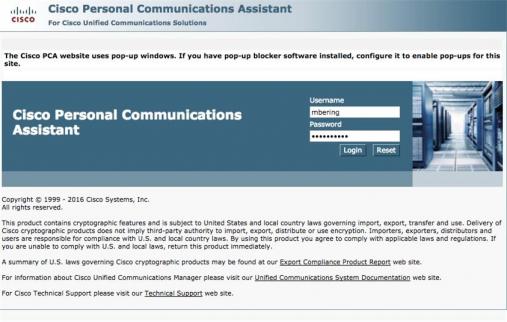
From the Home page, go to the Messaging Assistant by clicking the link or through the Navigation menu. If using the Navigation menu, select Messaging Assistant and then click the Go button.
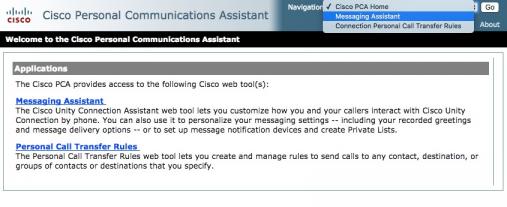
On the Messaging Assistant page, go to the Passwords menu and select Change PIN.

On the Change PIN screen, enter your new PIN in both the New PIN and Confirm New PIN fields, then click the Save button.
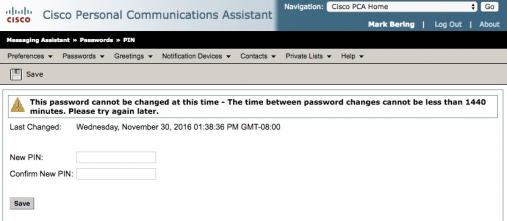
- Note: Temporary PINs provided will expire after 180 days and will need to be changed before then. Once a temporary PIN has been changed by a user or a Voice Team Administrator, after 1 minute, you can change the pin again.
Is it okay to use my old PIN?
- Yes. You can use the PIN you previously used to access voicemail on the old system, or feel free to create a new PIN. Your choice!
Will I still get notified of missed calls with the Cisco Unity voicemail system?
- Yes. Notifications of missed calls will be delivered to your Inbox.
Will I still get my voicemail delivered to my email address, so I can listen from my Outlook client with the new system?
- Yes. You be able to access and listen to your voicemail messages from your desktop or other devices on which you access your email.
What voicemail functions can I manage through the Outlook web app (OWA)?
- The new UCSF Voicemail service cannot be managed from the Outlook web app client. It is managed through a dedicated web portal, the Personal Communications Assistant.
- Log into the Cisco Personal Communication Assistant (PCA) web portal.
- Copy "https://voicemail.ucsf.edu/" to your clipboard. Note: There is a known issue with this version of the Cisco PCA that prevents direct access from a referral web page.
- Paste it into your web browser.
I have set up customized call-routing rules; will I be able to do that on the new system?
- There are two ways to set up call-routing rules: (1) personal call transfer rules and (2) auto-attendant key mapping. You can configure personal call transfer rules yourself using the instructions published here. To set up auto-attendant key mapping requires submitting a ticket to the IT Service Desk.
What features require submitting a ticket to the IT Service Desk?
- Requesting auto-attendant key mapping requires submitting a ticket to the IT Service Desk.
Voice commands
What are voice commands?
- Using your touch-tone phone, you can access the UCSF Voicemail system by dialing 66000 or 476-6000 to retrieve voicemail and your calendar. Voice command access is enabled in the Communication Assistant web portal; you can access the web portal by copying "https://voicemail.ucsf.edu/" to your clipboard, then pasting it into your web browser.
- Voice command allows you to complete the following tasks:
- Retrieve, listen to, reply to, create and forward voice messages
- Listen to or change calendar information
- Change personal options, such as changing a PIN, or call or send a voice message to a voicemail contact
What are the voice commands menu options?
- Play messages: Listen to new voicemail messages and delete messages.
- Play emails: Listen to new email messages and delete messages.
- Play meetings or List meetings: Listen to your schedule for the day, send "I’m running late" messages, cancel meetings or contact the meeting organizer.
- Call: Call a voicemail contact.
- Directory: Locate a contact by first name and last name.
- Play greeting: Play a specified greeting.
- Change my PIN: Change settings for your mailbox including your PIN.
- Note: To enable voice commands, log into the Communication Assistant web portal by copying "https://voicemail.ucsf.edu/" to your clipboard. Next, paste it into your web browser and switch your voicemail input type to voice recognition.
How do I activate voice command menu options?
- By default, your UCSF voicemail box is set up to use the telephone touch-tone keypad. However, you have the option of disabling your touch-tone keypad and enabling voice commands.
- To enable voice command options, complete the following steps:
- Call the UCSF Voicemail system using the number appropriate for your location, then log in.
- Press 9 to start using the voice command interface.
- Press 1 to confirm that you want to switch to voice commands.
- Note: When you delete a voicemail using the telephone system, the voicemail (email with sound file attachment) is also deleted from your Outlook mailbox.
How do I listen to a voicemail message via voice commands?
- To listen to voicemail, complete the following steps:
- Call the UCSF Voicemail system using the number appropriate for your location, then log in.
- When prompted, say "Play messages." Your most recent voicemail message is read.
- While listening, say any of the following options:
- "Beginning" to move back to the beginning of the message
- "Pause" to pause the message
- "Resume" to continue playing the message
- After listening, say one of the following options:
- "Save" to save your current message and move to the next message in your mailbox
- "Delete message" to delete the message
- Say "Main menu" to return to the main menu.
- Note: When you delete a voicemail using the telephone system, the voicemail (email with sound file attachment) is also deleted from your Outlook mailbox.
How-tos
How do I record my name?
- It is highly recommended that you record a personal greeting including your name to personalize your mailbox. If you do not record your name, callers will hear a computer-recorded voice that speaks your name.
- Call the UCSF Voicemail system using the number appropriate for your location and log in.
- From the main menu, press 4 to go to setup options.
- Press 3 to select your preferences.
- Press 2 to record your name.
- To accept your recording, press 1.
- To reject your recording and re-record, press 2.
How do I record alternate greetings?
- When you are out of the office or on the line, callers can hear short specific greetings for a number of defined cases.
- Call the UCSF Voicemail system using the number appropriate for your location and login.
- From the main menu, press 4 to go to setup options.
- Press 1 to go to your greetings menu.
- Press 3 to edit your greetings.
From the Greeting menu, press:
Keypad
Greeting
1
Standard - plays during normal business hours
2
Closed - plays after standard business hours
3
Alternate - plays during a specific time period when you want to indicate special circumstances
4
Busy - plays when you are on another phone call
5
Internal - plays when your internal number is dialed
6
Holiday - Plays a special greeting during a holiday
Sample Greeting: "Thank you for calling. You have reached the voicemail box for [Name]. Please leave a detailed message, and I'll return your call as soon as possible."
- Press 1 to record your greeting.
- Press # when you have finished recording.
- When finished leaving your message, you may press # for additional options or hang up. In the future, you may press # to bypass this greeting and leave a message.
How do I reply to a voicemail message?
- To reply to a voicemail message, complete the following steps:
- Call the UCSF Voicemail system using the number appropriate for your location, then log in.
- When prompted, say "Play messages." Your most recent voicemail message is read. If necessary, say "Next message" repeatedly until you locate the desired message.
- Say "Reply" to reply to the message. When prompted, record your message. Press # when you are finished.
How do I forward a voicemail message?
- To forward a voicemail message, complete the following steps:
- Call the UCSF Voicemail system using the number appropriate for your location, then log in.
- When prompted, say "Play messages." Your most recent voicemail message is read. If necessary, say "Next message" repeatedly until you locate the desired message.
- Say "Forward" to forward the message. Outlook Voice Access will ask you to search the directory to locate the name of the person to whom you wish to send the message. For the person you wish to find, (1) say the last name first or (2) spell the person's email address. When prompted, record your message.
How do I listen to a voicemail message via touch-tone?
- To listen to voicemail, complete the following steps:
1. Call the UCSF voicemail system using the number appropriate for your location, then log in to your mailbox.
- From a Campus phone, call x66000 or press the Message Waiting button on your phone.
- From an off-campus phone, call 415-476-6000 and press the Star key when you reach the voicemail system. You will be prompted for your ID; enter your 5-digit phone extension (UCSF St Marys staff enter full 10 digits).
- From a mobile phone, call 415-476-6000 and press the Star key when you reach the voicemail system. You will be prompted for your ID; enter your 5-digit phone extension (UCSF St Marys staff enter full 10 digits).
2. When prompted, press 1 for voicemail. Your most recent voicemail message is read.
3. While listening, press any of the following:
- Press 1 to move back to the beginning of the message.
- Press 8 to pause the message.
- Press 9 to fast-forward and skip portions of the message.
- Press 66 to have the message play faster.
- Press # to go to the end of the current message.
4. After listening, press any of the following:
- Press # to save message as is and move to the next message in your mailbox.
- Press 3 to delete the message. Note: When you delete a voicemail using the telephone system, the voicemail (email with sound file attachment) is also deleted from your Outlook mailbox.
- Press * to return to the main menu.
Do voicemail messages count against my mailbox quota?
- Yes. If your mailbox goes over quota, you will not be able to receive new voicemail messages, and callers will be told that your mailbox is full. Fortunately, most voicemail messages are relatively small (<50KB), but we recommend that you make it a habit to delete or archive messages (both email and voicemail) that are no longer pertinent to keep your mailbox size down.
If I delete a voicemail message from my Outlook email inbox, am I still able to listen to the message from my phone?
- No. When you delete a voicemail message in Outlook after listening to it, the message is no longer accessible by phone. To retrieve a previously deleted voicemail message in Outlook that is still accessible in your Deleted Items folder, move it back to your Inbox or any other folder you have created. If you want to access the voicemail by phone again, you must mark the message Unread.
- When you delete a voicemail message by phone, the message is no longer accessible by email.
Is it okay for people to leave me confidential information, such as patient or personal information, on a UCSF voicemail message?
- Although it is acceptable for people to leave confidential messages in voicemail, we strongly recommend you treat it like any sensitive electronic information and delete it as soon as possible after it is no longer needed.
- This will help prevent you from accumulating email messages with sensitive information. In addition, keeping as little as possible in your mailbox helps protect both you and UCSF.
Are "secure" voicemail messages allowed with UCSF voicemail?
- Yes. An incoming voicemail message received by the new voicemail system is converted to a conventional email message with transcription and a sound file attached. These messages are stored within the UCSF Exchange mail system and are treated with the same security controls as standard email messages. Email is already used for restricted information; go to the tutorial How Secure Email Works for further information.
- Please be aware that it is prohibited to automatically forward secure or nonsecure email or voicemail messages from your Exchange email to an external email service. Go to Use of Email at UCSF policy for further information.
- However, you may choose to manually forward a voicemail message to another Campus Exchange email address, just as you would any other standard email message. If the message contains restricted data, the subject line of the email should contain one of the following keywords, including the colon:
- ePHI:
- PHI:
- Secure:
Is voicemail text preview supported?
- No. This feature is not available at this time.
How do I choose the touch-tone keypad interface on my phone, instead of having to talk to the system?
- Call the UCSF Voicemail system using the number appropriate for your location, then log in.
- Press 9 to switch to using the touch-tone command interface.
- Press 1 to confirm that you want to switch back to voice commands.
How do I set up call-answering rules for voicemail?
- Call-answering rules allow you to choose how specific calls will be handled when you are away. These rules are set up using the Communication Assistant web portal.
- To change your PIN, log into the Cisco Personal Communication Assistant (PCA) web portal:
- Copy "https://voicemail.ucsf.edu/" to your clipboard. Note: There is a known issue with this version of the Cisco PCA that prevents direct access from a referral web page.
- Paste it into your web browser.
- Enter your UCSF email account username and password in the respective fields.
Click the Login button.

- From the home page, go to Personal Call Transfer Rules by clicking the link or through the Navigation menu. If using the Navigation menu, select Personal Call Transfer Rules, then click the Go button.

From the Personal Call Transfer Rules interface, go to the Destinations menu and select View Destinations from the drop-down menu.
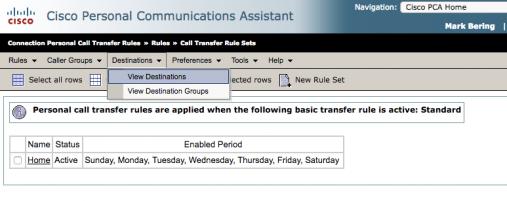
Click on the New Destination link in the Destinations toolbar to create a new destination.
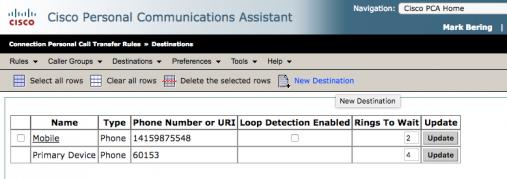
- Enter a name and phone number or URI for your destination, set the number of Rings to Wait, and choose whether to enable Loop Detection. Click the Save button to create your destination.

Now that you have a defined destination, you can set up a basic transfer rule. Go to the Rules menu and select View Call Transfer Rule Sets from the drop-down menu.
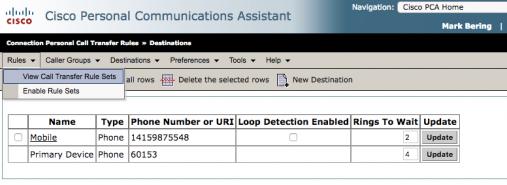
Click on the New Rule Set link to set up a new rule set.
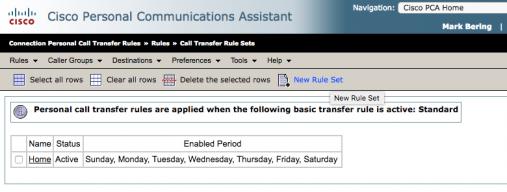
- Enter a name for your new rule set in the Name field.
- Use the media player to record the name of your rule set to use with the voice command features.
Click the Save button.
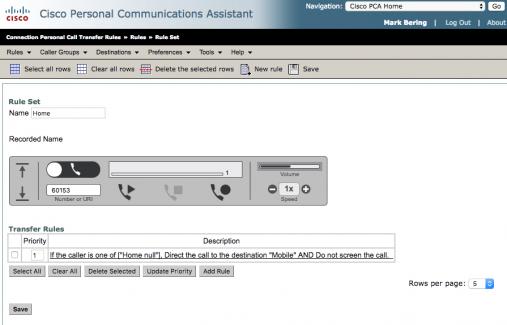
- We are now going to configure the rule-set parameters:
- If the rule set will be based on phone numbers, check the From/Not From menu and choose the appropriate option.
- If the rule set will be time-constrained, check the Received Between/Not Received Between menu and choose the appropriate option.
- If the rule set will be based on your calendar availability, check the I am in a meeting/I am not in a meeting menu and choose the appropriate option.
- Define the action to be taken by setting the Then transfer the call to: function by clicking the appropriate radio button.
- Click the Update Preview button to see a description of what the rule set will do.
Click the Save button.

To activate your rule set, go to the Rules menu and select Enable Rule Sets from the drop-down menu.
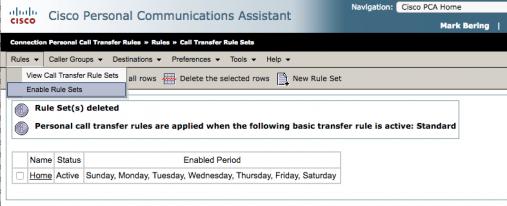
- Rule sets can be enabled by date range or days of the week. Choose when your rule set will be active by checking the appropriate box in the Enabled column (expand your date range by clicking the Add Date Range button).
- Click the Save button.
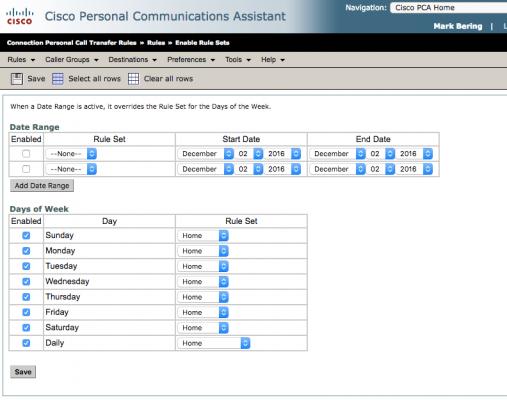
- In this documentation, you set up a simple rule. For more information, please see The Personal Calls Transfer Web Tool.
Note: If you are using a non-Campus number in your call-answering rule, you must prefix the number with "+1". Example: +1-415-222-1212. You will not be required to prefix a Campus number.
Will the University be providing training sessions for the new voicemail system?
- We are not planning on providing any training at this time. If training becomes necessary. we will plan sessions accordingly.
How do I save voicemail messages within Outlook for longer than 1 year (356 days)?
- Per the Unified Communication Operational Voicemail retention policy for all Cisco Unity Voicemail users, all Unity Mail Boxes will retain voicemail messages for 1 year (365 days).
- To save voicemail messages for longer than 1 year (365 days), you will need to create a new folder within your Outlook account and drag and drop these voicemail messages into it.